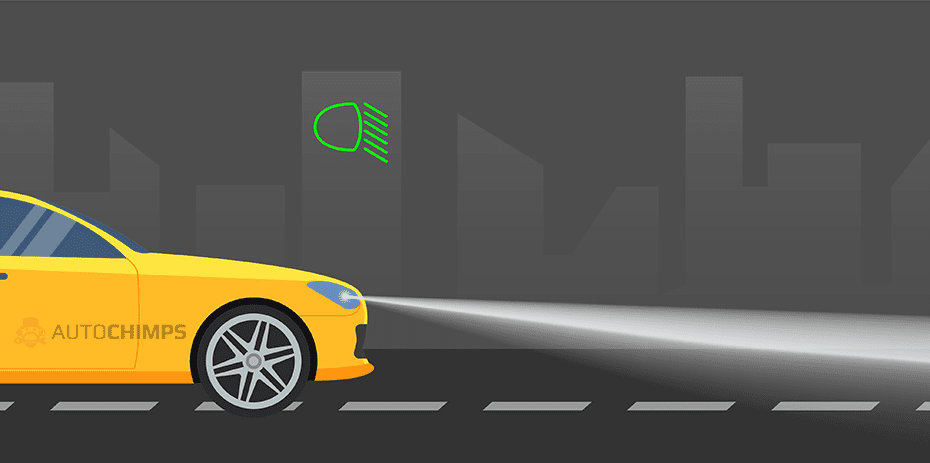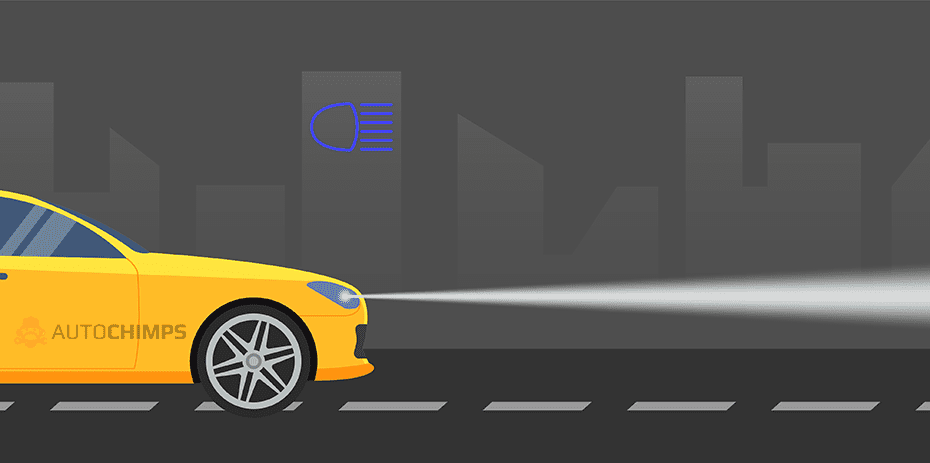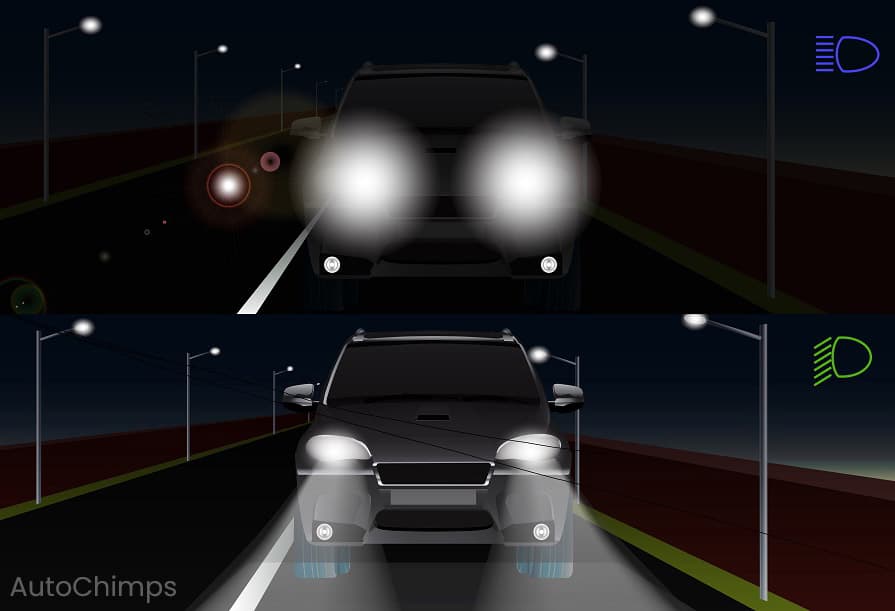Driving at night (or in otherwise dark conditions) is more hazardous than driving during the day.
Why?
You can’t see so clearly, making it more challenging to adapt to what’s happening or about to happen around you.
Headlights and fog lights are, of course, crucial to night driving. But which type should you use? And when?
In this guide, I will explore low beam vs. high beam vs. fog lights and explain when you should use each and what they’re intended for.
Table of ContentsShow
What Are Headlights vs. Fog Lights?

Headlights come in two settings: low beam and high beam. When you turn the headlights on, they’ll automatically set to low beam. You can activate the bright beam setting by either pushing or pulling the turn signal stalks (depending on your vehicle).
The difference between high beams and low beams will be explained below. In brief, high beams allows you to see much farther ahead (in most situations) but will blind other road users. As such, dim beams will be utilized much more often.
Don’t confuse the headlights with the sidelights/parking lights. These are the setting before the dim beams on the dial/stalk, and they remain on at the same time as the headlights to help them.
You can use sidelights while driving in the daytime to enhance your visibility to other road users. However, their original function was – and still is – to highlight your location when you’re parked on the side of a busy road or in thick fog.
Sidelights only draw a low wattage (which is why they aren’t very luminous), so they are carefully designed to not discharge a battery when left overnight. However, you should switch them off the following day and take your car for a good drive to recharge the battery.
Finally, fog lights. Fog lights are found in a separate unit from the headlights and sidelights. They can legally only be used in dense fog when visibility is less than 100 meters (328 feet). It’s crucial to remember to switch them on and off whenever appropriate.
When Should I Use Low Beam Headlights?

Low-beam headlights are activated by turning the dial on the dashboard or the turn signal stalk. Different manufacturers put this in alternative spots, but they’re almost always in one of these typical locations.
You should use low-beam headlights when you’re driving in the dim in the following situations:
- In a residential area
- When there’s oncoming traffic
- During a rainstorm/snowstorm/hailstorm
- In a tunnel
- When thick clouds significantly obscure the sun
- At dusk and dawn (it’s most difficult to see at these times as your eyes adjust)
- In parking lots
Low Beam Headlights Advice

They’re referred to as “dim beam” headlights because they direct the light downwards at the road, offering visibility up to approximately 300 feet. Older vehicles or vehicles with grimy headlights may have considerably reduced light range.
Since they point down at the road, low-beam headlights shouldn’t ever blind approaching traffic or vehicles ahead of you.
Low-beam headlights illuminate the road and make your presence obvious to other street users.
Exceptions might apply when you’re going over the crown of a hill or a speed bump. At this point, your car is temporarily angled so the lights could shine directly at another driver. However, this is short and unavoidable, so it isn’t considered hazardous.
You might have been surprised to read that low-beam headlights should be used when it’s raining or snowing. It’s actually crucial to do this.
Rain and snow reflect and refract light back at you. If you use your high beams, you’ll get much more reflective glare back in your eyes. It also risks blinding other drivers when driving in potentially dangerous conditions.
If you use low-beam lights, in contrast, you will find that your eyes are much more concentrated on the road ahead and your surroundings instead of the falling rain or snow.
When Should I Use High Beam Headlights?

Your powerful-beam headlights are activated by pushing or pulling the turn signal stalk, causing the bright-beam indicator to appear on your instrument panel. The low-beam headlights must already be switched on for the intense beams to be activated unless you’re just flashing your illumination.
Pulling the stalk to flash your lights momentarily activates the intense beams, ensuring whoever you’re communicating with sees your message.
Note: flashing your lights should only be done as a warning to other drivers. A misinterpretation caused by flashing your lights could lead to a collision, for which you’d be held liable.
Use your powerful high-beam headlights when you’re driving in the dim and:
- On open road
- When there isn’t any oncoming traffic or cars ahead of you
- You aren’t in a residential area (you don’t want to wake people up)
- When driving along dangerous roads (narrow, windy, gravel, cliffside, etc.)
High Beam Headlights Advice

High-beam headlights allow you to see much farther down the road. You can usually distinctly see at least 500 feet.
The danger with high beam headlights comes from blinding other drivers. The lights are exceptionally bright, and if another car in front of you (on either side of the road) isn’t prepared for it, you could cause a devastating crash.
Always turn your bright headlights off if anyone’s in front of you! This includes approaching traffic, vehicles ahead of you in your lane, stationary automobiles, and cars turning onto/off your road at an intersection.
Some modern cars come with sensors. These automatically switch the high beam on and off whenever it detects the presence of other vehicles. While these systems are excellent for drivers who regularly forget, they aren’t perfect. In reality, you should be concentrating more on manually switching the high beams on and off yourself.
If someone approaches you with their bright beams, flash your lights. This should alert them, and they’ll turn them off.
If they don’t and you feel your eyes starting to constrict, take your foot off the throttle pedal and look down at the edge of your side of the road. That’s down and to the right if you’re in the States. This means you can still see the road’s direction without being blinded. In severe cases, you might need to halt the car.
When Should I Use Fog Lights?

When driving in thick fog, it is recommended to utilize fog lights. These lights are specifically designed to significantly enhance the visibility directly in front of your car by illuminating a rectangular area.
In particular, you should use fog lights to get a clear view of the side of the road, allowing you to drive more securely.
Fog lights are exceptionally bright and dazzle other drivers even more intensely than high beams. It’s simple to forget and leave them on by accident, so you must always be watchful.
Use fog lights when: Visibility is severely reduced by fog, torrential rain, or snow You cannot see more than 100 meters ahead Conditions are particularly dangerous for driving You need to make your vehicle more visible to other drivers Remember to turn off fog lights when visibility improves to avoid dazzling other motorists.
- You’re driving in thick fog (less than 100 meters/328 feet of visibility) and struggling to see other road users around you.
- You’re driving in other hazardous situations inhibiting your view of the roadside, such as smoke, dust storms, sandstorms, and extreme rain.
You must switch your fog lights off as soon as visibility improves. This is enforced by legislation (depending on where you are), and failure to do so could land you a penalty.
Fog Lights Advice

You should only ever use fog lights in the most severe of circumstances. Most of us won’t ever need to switch them on more than a couple of times per year, although that depends on your regional climate.
Switching them off as soon as you can see better is completely vital.
Switching them on is equally crucial when visibility becomes extremely poor. This is both about helping you see the road and ensuring other vehicles – in front of and behind you – can see you.
Fog Lights vs. Low Beams
Despite what some people might tell you, fog lights aren’t the same as low-beam headlights. They’re much more dazzling and dangerous in the wrong circumstances.
Fog lights won’t make much difference to your long-distance visibility (hence the confusion) – they’re all about brightly illuminating the road directly in front of you.
Fog Lights vs. High Beams
Recognizing the distinction between when to use bright beams and when to use fog lights is essential.
Use fog lights for drastically diminished visibility – something is blocking the light. Use high beams (or low beams, whichever is most appropriate) for limited visibility – i.e., when it’s dark.
How Can I Get More Light From My Headlights?

Get more lights from your headlights by using high-quality, brilliant bulbs. You’ll find different bulbs with varying brightnesses, measured in lumens. Getting the highest one for the best visibility is usually a wise idea. However, you’ll need to ensure it’s compatible with your car and won’t dazzle other drivers.
You should also regularly check your bulbs. For this, you’ll need to sit in the car and get a friend to look at all the lights as you switch them on. They can then tell you which (if any) aren’t working.
I apologize, but there is no text provided after “Check:” for me to modify. Without a text to work with, I cannot perform the requested task of altering adjectives. If you’d like me to make these changes, please provide the complete text you want me to edit.
- Sidelights (front, rear, and license plate)
- Low beam headlights/rear lights
- High beam headlights
- Fog lights (front and back)
- Turn signals/hazard warning lights (front, back, and side)
- Brake lights
- Reverse light
A mechanic can also use an adjustment tool to ensure your headlights are positioned correctly. If they’re too low, you might not be getting adequate light. Too high, and they’ll blind other road users.
Finally, your headlight covers might be dirty. You could replace them, but it makes much more sense to consider purchasing a headlight cleaning kit. The Turtle Wax kit is widely touted to be the best if you know how to use it.
Spend around half an hour buffing down each headlight for each of the four grades before polishing at the end. Your headlights will be as clear as fresh.
Conclusion

And that’s low beam vs. high beam vs. fog lights! In summary, follow the subsequent guidance:
Use low beam headlights when driving slowly in busy or residential areas during dusk and when driving through tunnels. These headlights should be used as your regular headlights during the night.
**High beam headlights** – these are for fast speeds in country areas when you need to see further ahead. Remember to switch them off when other vehicles are in front of you!
Fog lights – these are for when your visibility is significantly impaired by fog or other comparable hazards.




